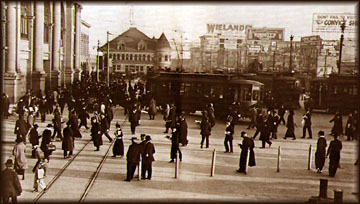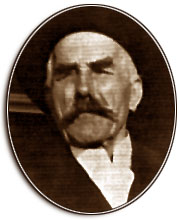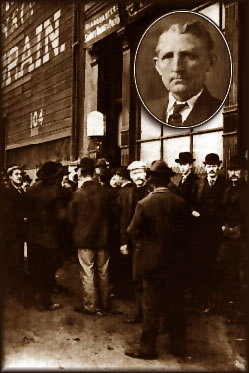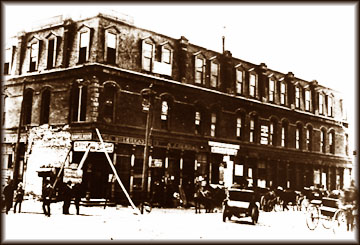Urban histories are formed by interpreting memorabilia, viewing architecture metaphorically, cataloguing myths and facts. It's an act of retrospection and occasionally, voyeurism. Structure is never mute. The interrogation of restoration reveals lost pasts. Heroes and values are identified and society proceeds with self definition. These are some stories and myths relating to San Francisco's Audiffred building.
San Francisco's emergence paralleled California's colonisation during the early part of the nineteenth century following the discovery of gold and victory in the war with Mexico. Urban growth was financed by "the usual suspects" of immigration, agriculture, industry, land speculation and greed for gold.

An enterprising local government expanded its revenue base by filling in the bay and selling "new" land to developers. Thus was created the lot on which the Audiffred Building rests. John Geary and Samuel Brannan, became the first owners of the site, paying the Town of San Francisco $850. Successful property speculators like triumphant warriors write their own histories. Streets in the City still bear their names. The site was resold to G. Male' and Hippolite d'Audiffred in December 1873.
 Audiffred had left france in 1850 at the age of twenty, for vera cruz, mexico, presumably to seek his fortune. twelve years later, france invaded mexico in support of a reactionary coup aimed at overthrowing an incumbent liberal regime. shortly thereafter, the french installed an austrian archduke as head of state.
Audiffred had left france in 1850 at the age of twenty, for vera cruz, mexico, presumably to seek his fortune. twelve years later, france invaded mexico in support of a reactionary coup aimed at overthrowing an incumbent liberal regime. shortly thereafter, the french installed an austrian archduke as head of state.
Maximilian, Emperor of Mexico, proved unusually incompetent by managing to alienate both his supporters and enemies. When the French army vacated Mexico in 1867, he stayed to fight on. Capture and execution followed. Needless to say, Audiffred found being French rough going in Vera Cruz around this time. Exercising common sense and a strong instinct for survival, he bought a donkey, loaded it with belongings and walked 2,500 miles to San Francisco.
Audiffred began modestly, selling charcoal to laundry operators in Chinatown. His wealth grew in proportion to the Chinese community. Some years later he teamed up with Mr. Male' to invest in real estate.
Little seems to be known about Mr. Male', except that he appears to have enjoyed his wealth. Legend has it that Audiffred's partner would ride up and down the Embarcadero in his buggy throwing silver dollars either into the bay or at passersby. Apparently Audiffred couldn't deal with Male's flamboyant ways. The eventual division of the business assets saw Audiffred winding up with the building site. During the 1880's, Audiffred decided he wanted to create a building to remind him of France he'd left some thirty years earlier.
There is no recorded evidence that Audiffred commissioned an architect. It seems likely that a profile of the building was developed by a draftsman working for the builder. It is also probable that the design is derived from sketches of 18th and 19th Century Parisian commercial buildings. The building distinctly follows the architectural style of that period. The Mansard Roof, housing a garret, punctured by tall, round-topped windows and decorated with heavy brick crenelation is a feature which can still be seen all over Paris today.
The building was completed in 1889 at a time when San Francisco had become the busiest waterfront in the western United States. The Embarcadero's docks and pier were filled with square-rigged ship plying commerce from all parts of the world.
Initial tenants of the Audiffred Building included a bar called the Bulkhead Saloon and Coffee Parlour. Located on the second floor in a small office was headquarters of the Coast Seamen's Union. Highly contentious waterfront industrial relations characterised America during the last decades of the 19th Century. Ship owners had little regard for the welfare or rights of sailors and seamen who made extensive commercial trade possible. Many attempts to organise seamen had either failed or had been put down by force.
The Coast Seamen's Union is notable because it became the first permanent sailors union in history. Its present-day incarnations are the International Seamen's Union and the Sailor's Union of the Pacific. These union's great influence in U.S. maritime union history can largely be attributed to a Scandinavian sailor, Andrew Furenseth whose activities began in the 1880's and lasted four decades.

A California ship owners "conspiracy" in 1901 led to a concerted effort to break the union. Furenseth marshalled his forces along the West Coast from the Audiffred building. Leading the union in a long and bloody strike, he eventually broke the ship owners. Strike action had for the first time resulted in a modicum of workplace rights being established, protecting merchant sailors from inhumane working conditions.
The basis of Furenseth's resolve is clearly stated in his simple poem.
"You can put me in jail
but you cannot give me narrower quarters
than as a seaman I have always had.
You cannot give me coarser food
than I have always eaten.
You cannot make me lonelier
than I have always been."
The Great Earthquake of 1906 marked a turning point in the development of the City. Almost 70% of the town was destroyed over a four day period. Much of San Francisco's waterfront was wiped out. However, period photographs show an unlikely Audiffred building standing alone in a Hiroshima-like landscape.

The story goes that the publican intercepted firefighters who were attempting to halt the fire by dynamiting waterfront structures. A deal was struck and firemen fought the flames for three days while consuming a firehose cart full of wine and two-quarts of whiskey per man. Seventy four years later, Hippolite's grandson Henry recalled the scene. "Gripping my hand, he walked me through the smoking ruins and suddenly spied our building....only a few bricks were missing. He gasped and said, ' Well, I'll be a sad son of a bitch!'"
San Francisco was rebuilt in the years following the earthquake and became the principal West Coast centre for transportation and commerce. A.P. Gianinni, an Italian immigrant, started The Bank of Italy in San Francisco during the 1920's. In 1928, one of his first branches opened for business in the Audiffred Building. Called the Harbour Branch it remained a major tenant until 1957. The Italian financier's banking network grew, mirroring the City's fortunes. Eventually it became The Bank of America, one of the world's largest multi-national corporations.
The Bank of Italy celebrated its new waterfront location by commissioning a frieze which still surrounds the ground floor of the eastern most section of the building. The subject is a series of beautiful medallions depicting scenes of lighthouses, dolphins, sailing ships and anchors.
San Francisco prospered after the first World War but was not immune to a world wide depression which followed the New York stock market crash of 1929. As business and commerce along the waterfront declined, relations between labour unions and management worsened dramatically.
Several unions represented waterfront trades at this time. Ironically, co-ordination between them was poor. For instance, sailors unions often disagreed with longshore unions as to whose men were responsible for unloading ships. The scuffle over turf created lifelong enmity amongst union heads. Maritime business's took advantage of the hard times and labour bickering by launching a campaign to break major union organisations.
Longshore workers became the focal point of a detailed union-busting strategy. At issue was the right to unionise all waterfront workers as well as the right to control hiring. The longshoremen were being organised by Harry Bridges, a former Australian seaman, from an office in the Audiffred Building. In mid 1934, Harry called a strike in San Francisco. Unionists followed in support, shutting down virtually every form of commerce in the three western coastal states. The Government of California took action bringing in the National Guard and within a short time San Francisco's waterfront was occupied by 10,000 troops.
On July 5, 1934, the strike turned ugly. Armed guardsmen battling rioters killed two longshoremen outside the Audiffred Building. To this day seagoing unions of San Francisco sponsor an annual commemoration of "Bloody Thursday" outside the building in honour of the murdered strikers.
Ultimately, the strikers prevailed, setting new standards for waterfront workers throughout the country as well as cementing the power of unions in San Francisco. Harry Bridges went on to form the Industrial Longshoremen's and Warehousemen's Union (I.L.W.U.) which he presided over from 1937 to 1977. This mythic labour figure died in 1990
During his lifetime Harry was variously:
- accused of being a communist
(Premier Kruschev said he was the only person worth visiting in America)
- unsuccessfully tried for deportation
- responsible for a US Supreme Court decision in support of free speech
- the leader of a record breaking 134 day strike in 1971
- reformer of outdated waterfront practices opening the way for automation.
- a crusader against union corruption
San Francisco's great bridges were built during the late 1930's. The City spilled over them into the North Bay and East Bay. Ground transportation diversified commerce away from the port as industrial distribution hubs moved to Oakland. Ferries became less important. The end of World War II marked a serious decline in San Francisco's waterfront.
The Embarcadero around the Audiffred Building turned into a skid row as the remaining financial centres moved uptown towards Montgomery Street. In 1946, as if to signal the final demise of the old waterfront, the Seven Seas Club became a tenant in the Audiffred. It was a home for homeless sailors.
Around this time the property was sold by the Audiffred family to a doctor and a lawyer. The doctor was Bill Weiner an obstetrician and gynaecologist. The lawyer was Wayne Collin, a civil libertarian attorney, who defended Iva Ikuki Toguri D'Aquino otherwise known as Tokyo Rose in a controversial treason trial.
Tokyo Rose was the nickname given by U.S. troops in the Pacific to at least a dozen women who broadcast enemy propaganda and music to them from Japan during World War II. Iva who had been visiting Japan at the outbreak of hostilities steadfastly claimed to have acted under duress. She was convicted of treason in 1949 in a case where popular desire for retribution clashed with calls to preserve the rights of unpopular minorities. It is a truism that victors get to write "history"as well as define appropriate levels of justice. Iva was imprisoned until 1956. On January 19, 1977, President Gerald R. Ford granted her a pardon.
The life in the building continued giving rise to yet another set of eccentric occupants. In 1948, the San Francisco School of Art underwent a major cultural upheaval (schism) within its administrative structure. Hassel Smith, a prominent artist, left the school and set up his studios in the third floor of the Audiffred. Over the next seven years, the upper floors of the building became home to many famous West Coast literary and artistic tenants. Among the most notable were Howard Hicks, Soniko Geschtoff, Joan Brown, Herbert Wasserman, Frank Lobdell, Peter Burriskov and Lawrence Ferlinghetti. The artist studios closed in 1955 when the top two floors of the Audiffred were condemned
The artistic occupants of the Audiffred Building reflected an embryonic and somewhat anarchistic social movement searching for an alternative to the conformity which had overwhelmed post-war American society. The desire for change was initially realised in the avant guardist culture of the Beat Generation. A different and later manifestation of alternative societal views came with the populist anti-war and drug cultures of the 1960's.
It is paradoxical that while artistic rebels occupied the Audiffred, urban planners in San Francisco were laying out their own vision of the new America. They designed a four-story freeway which was built around the Embarcadero during the 1960's. This traffic megalith cut the city off from a waterfront universally recognised as one of the most beautiful and spectacular in the world.
By 1969 the Audiffred building was boxed in by a multi level freeway and lay in the heart of skid row. It's principal tenant was a saloon called Riordans, the kind of place where looking sideways at the drinker next to you would earn a fist in the mouth. Other tenants came and went in the remaining ground floor shop fronts. In 1978, a cook, working Dory's Club, a fast-food place, tried to mend some basement plumbing with a welding torch. An exploding a gas main set fire to the building completely devastating the interior.and leaving only the delicate brick facade. The Audiffred building was condemned and scheduled for demolition.
Vital cities are flourishing organisms reconstituting themselves in the face of economic and social change and causing structures to cycle from one existence to another. Commercial activity in San Francisco had once again spread back toward waterfront as the intensive urban development and property speculation of 1970's fuelled further development and growth.
Thanks to the enthusiasm of the people of San Francisco and encouragement offered by the US Department of the Interior the building was saved. On May 1981, The Audiffred building, Landmark number 7 of the City of San Francisco, was placed on the National Register of Historic Places. Mayor Dianne Feinstein officiated at the ground breaking ceremony on March 16, 1982.
Aided by government tax credits for historic rehabilitation, the Audiffred building's difficult and complex restoration was accomplished over a two year period. The opening celebration was heavily attended taking place in April 18th, 1984, the 78th Anniversary of the Great Earthquake.
Hippolite's 90 year old grandson Henri reflecting on the old waterfront and the present up market tenants was heard to muse......"you know ...the old waterfront really got a bum rap....they said it was full of drunken sailors and whores....hell...we were too broke to buy booze...and all the whores were uptown with the businessmen who had real dough"
In 1989 an earthquake severely damaged the four story freeway next to the building, leading to the roadways eventual demolition. The City got back its waterfront and at the Audiffred building.... only a few bricks were missing.
RELATED LINKS
Museum of the City of San Francisco
http://www.sfmuseum.org/
Harry Bridges
http://www.wolfe.net/~yukon/harryb.html
The Beat Generation
http://www.charm.net/~brooklyn/LitKicks.html
American Civil Liberties Union
http://www.aclu.org/
Bank of America
http://www.BankAmerica.com/
National Register of Historic Places
http://www.cr.nps.gov/nr/nrhome.html
Labor Activists
http://www.igc.org/igc/labornet/
Maritime Museums
http://www.min-equip.fr/france.ocean/a_musee.html


 Audiffred had left france in 1850 at the age of twenty, for vera cruz, mexico, presumably to seek his fortune. twelve years later, france invaded mexico in support of a reactionary coup aimed at overthrowing an incumbent liberal regime. shortly thereafter, the french installed an austrian archduke as head of state.
Audiffred had left france in 1850 at the age of twenty, for vera cruz, mexico, presumably to seek his fortune. twelve years later, france invaded mexico in support of a reactionary coup aimed at overthrowing an incumbent liberal regime. shortly thereafter, the french installed an austrian archduke as head of state.
